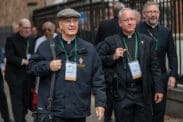 Photo by Johnathon Kelso
Photo by Johnathon KelsoAtlanta
Priest formation process updated
By MAUREEN SMITH, Special to the Bulletin | Published November 10, 2022
ATLANTA—In July of this year, the U.S. Conference of Catholic Bishops (USCCB) approved an update to the document that outlines how the formation of priests should happen in dioceses. The update reframes the process and adds a period of active discernment at the beginning as well as a period of synthesis at the end.
Each bishop is responsible for making sure young men are properly prepared for the priesthood, but the USCCB sets the guidelines and benchmarks for that formation in a document called the Program for Priestly Formation (PPF).
Men who are preparing for the priesthood attend academic classes in philosophy, theology and scripture; they learn the mechanics of how to administer sacraments and celebrate the Mass; but they must also undergo an interior transformation to be prepared for ministry.
“While priests need to know theology well, there is a recognition that maturing as a human being, continually strengthening his relationship with God, and being prepared with pastoral skills should also receive increased attention,” explained Father Luke Ballman, a priest of the Archdiocese of Atlanta who is currently the executive director of the Secretariat of Clergy, Consecrated Life & Vocations for the USCCB.
“The previous edition used intellectual terms to describe the movement through formation: college seminary, pre-theology, and theology; less intellectually-focused terms are used in this new edition, namely, the propaedeutic stage, discipleship stage, configuration stage and vocational synthesis stage,” he continued.
Atlanta’s director of vocations, Father Rey Pineda, said that the update will add some time to the whole process, but feels it is time very well spent.
“I don’t think the church is simply saying that men need more time in seminary. I think instead what is being communicated is that the church needs to provide the proper space and resources to meet the men that are being called and journey with them more closely in order to serve the realities of ministry today,” said Father Pineda.
The period of prayer and discernment at the beginning is called the propaedeutic stage.
“During this stage, the man is introduced to the life of the church as a community in which excellence of character is nurtured, to the practice of daily participation in the Holy Mass, to love for Sacred Scripture, to other liturgical prayers and personal prayer, and to the basic elements of the Christian faith as he discerns attentively and purposefully his potential vocation to priesthood in the presence of a supportive community of fellow seminarians and priests,” said Father Ballman.
Seminarians can take some classes during this stage, especially those who are studying under a visa, but the focus is on personal development and discernment. While many stages will take about a year, there is no set limit. The updated program uses benchmarks to measure how a man is moving through the process. This helps bishops, vocation directors and seminaries look at each individual and his progress instead of relying on a timeline that may not take personal development into account.
Father Ballman says the update offers added benefit to the seminarian.
“(This) edition emphasizes more than previous editions that the seminarian is the protagonist of his own formation, meaning he must take ownership of his journey, and not simply respond passively to what others are telling him. The benchmarks, as markers of growth, help him determine how he is maturing in his relationships with others (critical for his ability to make a gift of himself to the church as a priest), how he is growing in his relationship with Jesus Christ, and how he is growing in his ability to offer himself to others in pastoral charity,” he said.
At the end of the propaedeutic stage, a seminarian moves into the discipleship phase when he completes college and pre-theology studies and then the configuration stage when he completes theologate programs. The last stage is also new.
“In the vocational synthesis stage, the man leaves the seminary and experiences a life of self-giving in a pastoral setting, as he begins the transition to full-time ministry. He spends six months minimum in a pastoral setting serving as a deacon (all priests are ordained deacons first), where he takes on the identity of a priest as he gradually assumes the duties of parochial ministry,” said Father Ballman.
Father Pineda hopes the updated program will encourage more men to enter into formation and consider what God is asking of them.
“(It) recognizes that men entering seminary are coming from substantially different backgrounds. Home life and upbringing are different, most times coming from less religious household or from a less-traditional family structure. They are men who, often at no fault of their own, have not received proper human or spiritual formation at home. What I love is that this declares that an unusual upbringing is not an impediment, but instead that the church has to be able to address and provide the support for men to grow and give them the best possibility at being formed to serve the people of God,” he said.
Father Pineda added that he believes this update will form priests who are much better prepared for ministry.

